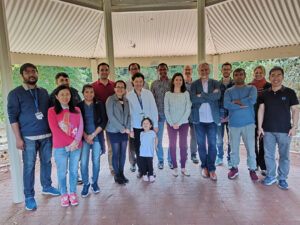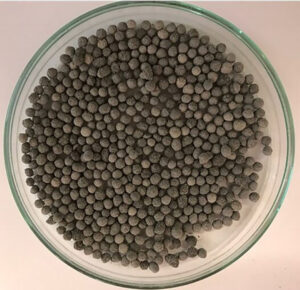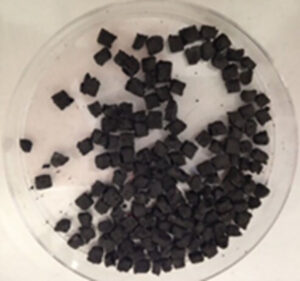One atom thick – The top four most promising uses of graphene in agriculture

The many extraordinary properties of this material give it an amazing range of potential applications to grow better crops.
One to watch closely – that’s how we should describe graphene in terms of a material with huge potential to improve agriculture.
First, a look at its structure and characteristics of this material, which was only discovered in 2004.
Graphene is a single layer of carbon atoms arranged in a crystal lattice, and it’s the basic building block of graphite, the material that is used in pencil lead and other materials. It can be mined or manufactured. Graphene possesses enormous strength of 42 N/m, which is 200x stronger than the strongest steel. It also maintains its initial size, no matter how much it is stretched.
However, graphene is also extremely light, weighing only 0.77 mg/m2. In addition, it has extremely high optical transparency of up to 97.7% and high thermal conductivity of 5000 W/m/K, despite being only an atom thick.
Possibilities of use in agriculture
Graphene already has many exciting possibilities of use in agriculture as outlined by a group of Brazilian scientists in a recent review paper. Drs. Luciana Fonte and Andre May of Embrapa (Empresa Brasileira de Pesquisa Agropecuária Meio Ambiente), and Matheus Suenson and Dunieskys Larrudé of AutoScience Technologies, explain that the reason graphene has such potential to positively impact global agriculture is because it’s “extremely versatile.”
Graphene oxide (GO) is of particular interest. It’s a negatively-charged layer to which can be adhered – for example – ‘cationic’ micronutrients such as zinc and copper or ‘anions’ such as negatively-charged phosphate. GO is also chemically inert when it undergoes a controlled process of purification and neutralization with pH control after its synthesis.
Graphene also has a wide range of existing and potential industrial uses, and at this point, graphene production plants in various parts of the world are increasing their capacity, explain Fonte, May, Suenson and Larrudé. However, widespread use of the material is not yet a reality. “The barriers are related to costs,” they note, “but there are technologies in Brazil that are already changing this reality.”
Here are the top four most exciting current and potential uses of graphene:
1. Next-generation fertilizers (nanoencapsulation and smart-release systems)
Graphene is being used to develop new slow-release fertilizers, which improve fertilization uptake by plants and also prevent excess nutrient losses in soil and waterways. Release of phosphorus is slower with GO-iron-phosphorus composites compared to the well-established commercial fertilizer monoammonium phosphate (MAP). Fonte, May, Suenson and Larrudé report that there are already start-ups using graphene to make slow and ‘intelligent’ fertilizer release products. These applications as being spurred, they say, because “the study of graphene dispersion in biodegradable polymers is widespread.”

A collaboration of researchers at the University of Adelaide in Australia (Dusan Losic at the School of Chemical engineering and Mike McLaughlin at the Center for Fertilizers at the School of Agriculture, Food and Wine) have already successfully demonstrated two concepts for slow-release fertilisers using graphene materials in recent years, explains Professor Dusan Losic, nanotechnology leader in the University’s School of Chemical Engineering and Director of the University’s Australian Research Council (ARC) Research Hub for Graphene Enabled Industry Transformation. One is the loading of micronutrients onto specially-formulated powders with graphene oxide sheets used as carriers. The patent for this technology is licensed to a large fertilizer company partner and commercialization is underway. The other is coating commercial fertilizers granules (MAP etc.) with very thin graphene layer that improves mechanical strength of fertilizer, reduce dusting during application.
Using graphene materials as nutrient carriers, says Losic, “was less efficient for macro nutrients but possible with specific tailoring of graphene material chemistry to enhance their binding that will provide slower release. This concept is also demonstrated by combining micronutrients and phosphate delivery, and has been described in published paper.”
Regarding cost, Losic says the price of graphene materials is now significantly reduced. He adds that “considering the benefits of their performance, the additional cost of graphene materials [in fertilizer delivery] can be compensated by these performances for specific applications.”
2. Plant growth stimulators and fertilizers

Graphene can increase germination rates and stimulate plant growth. Low graphene concentrations have been shown, for example, to accelerate the germination of tomato seeds, explain Fonte and her colleagues in their review paper. Graphene penetrates the seed epidermis, making it break more easily and allowing the seed to imbibe water quickly.
However, graphene can also have contradictory effects of plants depending on various factors such as time of exposure, concentration, particle size and plant species. Fonte and her colleagues note that “further research is warranted to determine the appropriate concentration to improve plant growth without causing phytotoxicity and negative environmental changes.”
3. Antifungal and antibacterial agents
According to Fonte and May, “graphene has antifungal activity, which makes it an excellent product for the development of new fungicides. Reduced GO has the potential to inhibit the mycelial growth of three disease-causing fungi (Aspergillus oryzae, Fusarium oxysporum and Aspergillus niger), through damage to the microbiota membrane, changes in electron transport and oxidative stress.”
In their paper, they also explain that graphene is cytotoxic to bacteria. E. coli and Pseudomonas aeruginosa are known to have their growth inhibited by GO and ‘reduced’ GO nanoparticles.
4. Amplifying pesticide power
Already by 2019, a group of scientists in China had found excellent synergistic activity for GO used with three common insecticides to control the Asian corn borer: β-cyfluthrin (Cyf), Monosultap (Mon) and Imidacloprid (Imi)).
The GO-Cyf, GO-Mon and GO-Imi mixtures exhibited 2.1, 1.51 and 1.83-times higher contact toxicity than any single insecticide of Cyf, Mon and Imi.
As the scientists state in their paper, the synergistic mechanism may be that GO can cause ‘physical damage’ to the cement layer of insects, resulting in a rapid water loss, the disrupted cement layer provides a new channel for the penetration of insecticides, and/or the GO delivery system can enhance the efficacy of the insecticides.
Looking forward

Losic notes that all these applications have their own merits and advantages comparing with existing technologies in terms of performance, costs, practicality and potential environmental impacts. “What is the most promising application is hard to say right now,” he says.
Losic adds that even though graphene materials are currently recognized as nonhazardous, non-toxic, and some (for example, GO) are biodegradable, more research is needed on potential environmental impacts before there can be stronger confidence in agricultural applications.
Overall, Losic says we shouldn’t believe there will be one ‘winner’ in terms of graphene uses in agriculture. In addition, he thinks “we can expect more new and different applications to emerge.”
Join 17,000+ subscribers
Subscribe to our newsletter to stay updated about all the need-to-know content in the agricultural sector, two times a week.



